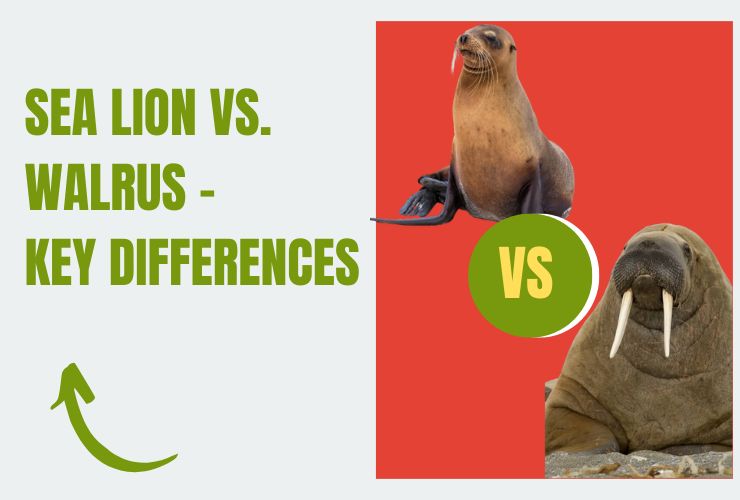Sea lions and walruses, while both being marine mammals, are significantly different in numerous ways.
A key distinction is their tusks: Walruses possess long, sharp tusks used for breaking ice and self-defense, while sea lions lack these. Additionally, walruses have thicker, wrinkled skin compared to the sleek coat of sea lions. Sea lions are known for their agility, while walruses are more bulky and slower on land.
Isn’t the ocean fascinating, with its diverse array of species, each unique and intriguing in its own way? When you think about sea creatures, your mind probably imagines the graceful sea lion or the impressive walrus. These are two popular marine mammals, yet people often mix them up.

But the truth is, they are very different! Keep reading to explore the differences between sea lions and walruses! You’ll be surprised at the incredible information that awaits!
Sea Lion vs Walrus – A Quick Comparison
Let’s take a quick look at the differences between these two creatures.
| Feature | Sea lion | Walrus |
| Scientific name | Zalophus californianus | Odobenus rosmarus |
| Family | Otariidae | Odobenidae |
| Body Shape | A streamlined, sleek body | Large, bulky body |
| Tusk | Absent | Prominent, long tusks |
| Skin | Sleek, smooth fur coat | Thick, wrinkled skin |
| Size | Up to 10 feet long, weighing up to 390 kg | Up to 11.5 feet long, weighing up to 1,500 kg |
| Diet | Primarily fish and squid | Mollusks, fish and birds |
| Habitat | Pacific Ocean, coastal and open water | Arctic regions, coastal waters |
| Social Behavior | Highly social, form colonies | Less social, usually in small groups |
| Lifespan | Up to 30 years | Up to 40 years |
| Gestation period | About 11-12 months, a single pup born | About 15-16 months, a single calf born |
| Conservation status | Least concern | Vulnerable |
Sea Lion vs Walrus: What Are The Key Differences?
Sea lions and walruses are two marine mammals often mistaken due to their similar amphibious lifestyles. Both have flippers that aid in swift swimming and lumbering movement on land.
However, don’t be fooled – there are distinct differences between sea lions and walruses that clearly set them apart. Let’s dive deeper and explore the unique characteristics of these ocean giants.
01. Taxonomy and Scientific Classification
Sea Lions and Walruses belong to different families within the order Carnivora.
Sea Lion
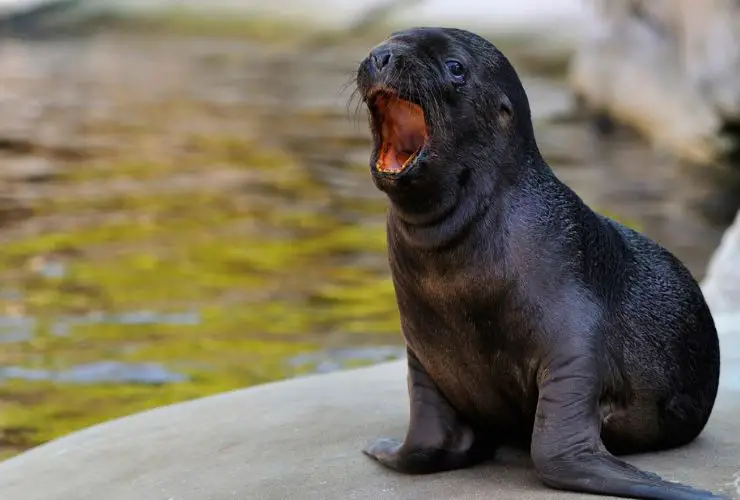
Sea Lions belong to the Otariidae family, also known as “eared seals.” They are characterized by their external ear flaps, large fore flippers, and the capability to walk on all four.
According to an article published in the article Systematics and Biodiversity, six common species of Sea Lions include:
- Steller Sea Lion (Eumetopias jubatus)
- California Sea Lion (Zalophus californianus)
- South American Sea Lion (Otaria flavescens)
- Australian Sea Lion (Neophoca cinerea)
- Southern sea lion (Otaria byronia)
- Hooker’s sea lion (Phocarctos hookeri)
Walrus
Walruses are in the family Odobenidae. This family used to have multiple species, but the Walrus (Odobenus rosmarus) is the only surviving species.
Walruses are easily recognizable due to their long, protruding tusks and the ability to “haul out” onto land or ice using their strong front flippers.
| Classification | Sea Lion | Walrus |
| Kingdom | Animalia | Animalia |
| Phylum | Chordata | Chordata |
| Class | Mammalia | Mammalia |
| Order | Carnivora | Carnivora |
| Family | Otariidae | Odobenidae |
| Genus | Varies (Eumetopias, Zalophus, Otaria, etc.) | Odobenus |
| Species | Varies (E. jubatus, Z. californianus, O. flavescens, etc.) | O. rosmarus |
02. Habitat and Distribution
Both Sea Lions and Walruses are marine mammals, but they have different preferences for temperature, habitat type, and geographical location.
Sea Lion
Sea Lions are found primarily in the Pacific Ocean, mainly in
- Bering Sea
- Southern South America.
- Tierra del Fuego
- Falkland Islands in the southern Atlantic Ocean
- Australia
- New Zealand.
They prefer temperate and subarctic waters and are widespread, inhabiting a variety of marine environments, from open oceans to coastal shallows.
You will often see Sea Lions lounging on the shores of coastal areas, islands, and even navigational buoys. They move to rocky and sandy beaches for breeding and resting.
Walrus
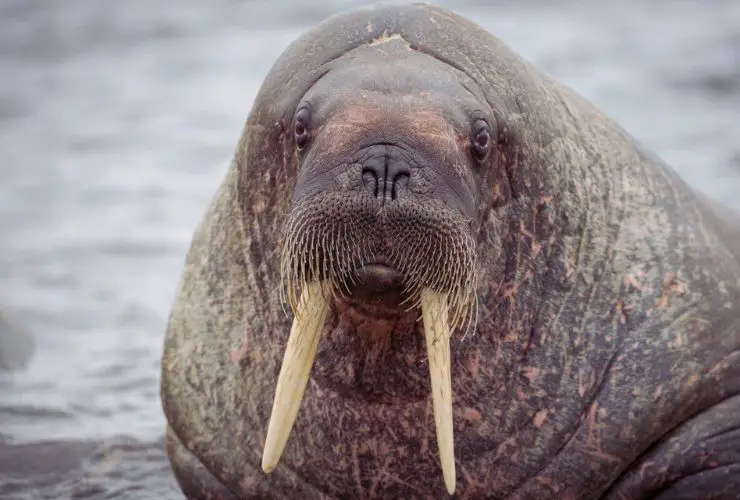
Walruses are found in the cold waters of the Arctic Circle, mainly residing in
- Europe
- Canada
- Greenland,
- Russian Federation
- Svalbard, and Jan Mayen
- United States (Alaska).
They live in coastal areas where they can haul out onto ice or land, as detailed by the University of Alaska Fairbanks.
Walruses are migratory, with their movements largely dictated by the presence of sea ice and food availability. During the summer, when ice melts, walruses can be found on the shores of islands and continents around the Arctic.
| Aspect | Sea lions | Walruses |
| Habitat | Temperate to subarctic marine waters | Cold Arctic marine waters |
| Habitat Preferences | Ocean Floor, Rocky and Sandy Beaches, Coastal Areas | Ocean Floor, Ice Floes, Rocky and Sandy Beaches (especially during ice melt), Coastal Areas |
| Distribution | Pacific Ocean | Arctic Circle |
03. Physical Appearance
Sea Lions and Walruses have different physical appearances, which include differences in body shape, size, color, and distinctive physical features.
Sea Lion

- Shape and Size: Sea Lions have a streamlined body shape designed for agility in the water, with adult males typically larger than females. The length varies among species, with the Steller Sea Lion being the biggest. It can reach lengths up to 10 feet (males) and weigh over 1,120 kg, as detailed by the IUCN Conservation Library.
- Coloration: Sea Lions typically have a brownish or tan coloration that darkens when wet and lightens when dry.
- Flippers: They have large, long front flippers that they use for propulsion in the water and to walk on land.
- Ears: One key feature of Sea Lions is their external ear flaps, distinguishing them from “true” seals.
Walrus
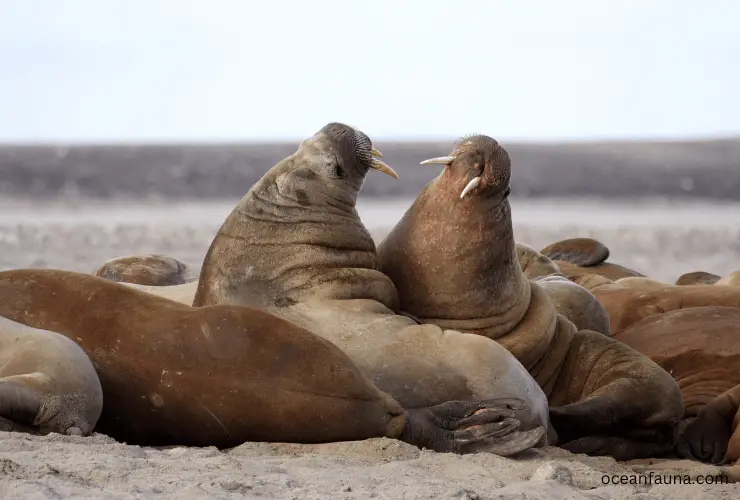
- Shape and Size: Walruses have a bulky body shape, with both sexes growing up to 11.5 feet long and males weighing up to 1,700 kg.
- Coloration: Walruses typically have a pink or brownish skin color that appears wrinkled and rough. When they are cold, they can appear almost gray as the blood vessels beneath the skin contract, as detailed by Ronald Aart Kastelein.
- Flippers: Walruses have short, strong flippers that are used for swimming and for hauling their heavy bodies onto ice or land.
- Tusks: Walruses are known for their long, protruding tusks, which are elongated canine teeth that can grow up to 1 meter in length.
- Whiskers: They also have a highly sensitive area of short bristles, or vibrissae, around their mouths that they use to locate food in the dark ocean bottom.
| Physical Feature | Sea Lion | Walrus |
| Body Shape | Streamlined | Bulky |
| Size | Up to 10 feet long (males of Steller Sea Lion) | Up to 11.5 feet long |
| Color | Typically brown or tan | Pink or brownish skin; can appear almost white when cold |
| Front Flippers | Large and long | Short and strong |
| External Ears | Present | Absent |
| Tusks | Absent | Present |
| Whiskers | Present (short) | Present (long and sensitive) |
04. Diet and Feeding Habits
Sea Lions and Walruses, while both are carnivorous marine mammals, have different diet preferences and feeding habits, mainly influenced by their habitats, available food sources, and distinctive physical features.
Sea Lion
Sea Lions primarily feed on a variety of fish species and cephalopods like
- Squid
- Octopus
- Salmon
- Herring
- Mackerel
- Anchovies.
They also occasionally consume crustaceans and other invertebrates. They have a high metabolic rate and need to consume a large quantity of food.
Did you know? Adult Sea Lions can consume about 5-8% of their body weight daily. ~ Source
They are known for their agile swimming skills and sharp teeth, which they use for catching and tearing apart their prey.
Walrus
Walruses have a specialized diet that primarily consists of benthic invertebrates like
- Shellfish
- Clams
- Mussels, and other bivalves.
They also sometimes eat
- Amphipods
- Tunicates
- Worms,
- Snails,
- Soft-shell crabs
- Shrimp
- Sea Cucumbers
- Some species of slow-moving fish.
Walruses have unique feeding habits. They use their sensitive whiskers to locate prey on the ocean floor and then create a jet of water with their mouth to uncover buried animals.
Once the prey is located, Walruses use their powerful suction ability to extract the soft parts of shellfish from their shells.
Did you know? An adult Walrus can eat up to 6,000 clams in just one day. ~ Source
| Aspect | Sea Lion | Walrus |
| Diet | Fish, cephalopods, crustaceans, and other invertebrates | Benthic invertebrates, especially clams, occasionally slow-moving fish |
| Feeding Habits | Agile swimmers; use sharp teeth for catching and tearing apart prey | Use whiskers to locate prey; create a jet of water to uncover buried animals; use the suction ability to eat shellfish |
| Daily Consumption | Approximately 5% to 8% of their body weight | Up to 6,000 clams in a day |
05. Social Behavior
Both Sea Lions and Walruses are social creatures but have different social interaction patterns, communication, and territorial behavior.
Sea Lion
Sea Lions are highly social and intelligent animals that live in large, noisy colonies. Their social structure is complex and organized, with colonies including both females and males. However, the males are dominant and maintain harems of females, as detailed in research published in American Zoologist.
Males, also known as bulls, establish territories during the breeding season and display aggressive behavior to defend their space and females. This can include vocalizations and physical combat with other males.
According to the journal Behaviour, communication among Sea Lions is rich and varied, involving a range of vocalizations, such as bark, growl, and grunt posturing.
Walrus
Walruses are also very social and often seen in large groups, especially on land, where they gather in massive herds that can number in the thousands. They establish dominance hierarchies, typically with the largest males being the most dominant.
During the breeding season, male Walruses become very aggressive and compete for access to females, often engaging in fierce battles that involve their large tusks. There is significant sexual separation during the non-breeding period, with males often found in regions away from females and their offspring.
Communication among Walruses involves a range of vocalizations, including barks, coughs and roars when excited, whistles by males during mating time, and soft calls from the females toward their offspring, as detailed in Ethology and Behavioral Ecology of Otariids and the Odobenid.
| Aspect | Sea Lion | Walrus |
| Social Structure | Complex, with male-dominant harems | Large herds with size-based dominance hierarchies |
| Aggression | Males display aggression during the breeding season | Males become very aggressive during the breeding season |
| Communication | Use vocalizations, body posturing, and physical interactions | Use vocalizations and physical displays |
06. Reproduction and Lifecycle
Sea Lions and Walruses have fascinating and distinct reproductive behaviors and lifecycles. Below are the reproductive details of both these marine mammals:
Sea Lion
- Mating behavior: Sea Lions exhibit sexual dimorphism, with males being significantly larger than females. They have a polygynous breeding system with dominant males, as detailed in an article published in Aquatic Mammals.
- Mating season: The mating season for Sea Lions typically falls in the summer months. During this time, males will fight fiercely for control over females.
- Gestation period: After mating, the gestation period lasts about 11 months, including a delayed implantation period of about 3 months.
- Calves: The female usually gives birth to a single pup, which she will nurse for at least six months, although weaning can continue for more than a year.
- Sexual maturity: Sea Lions reach sexual maturity between 4-5 years for females and nine years for males.
- Lifespan: The lifespan of a Sea Lion can be up to 20 years for males and slightly longer for females, often up to 30 years.
Walrus
- Mating behavior: Walruses also display sexual dimorphism and have a polygynous breeding system.
- Mating season: Their breeding season typically occurs in winter, with males competing for females through displays of aggression and strength.
- Gestation period: Following mating, Walruses have a gestation period of about 15-16 months, including a delayed implantation period.
- Calves: The female gives birth to a single calf which she will nurse for over two years, as detailed by COSEWIC.
- Sexual maturity: These animals reach sexual maturity around 7-10 years for females and 15 years for males.
- Lifespan: The lifespan of Walruses can reach almost 40 years in the wild.
| Reproduction | Sea Lion | Walrus |
| Mating Season | Summer months | Winter |
| Gestation Period | Approximately 11 months (including delayed implantation) | Approximately 15-16 months (including delayed implantation) |
| Calving | Single pup, nursed for at least six months | Single calf, nursed for over two years |
| Sexual Maturity | Females: 4-5 years, Males: 9 years | Females: Around 7-10 years, Males: Around 15 years |
| Lifespan | Males: Up to 20 years, Females: Up to 30 years | Up to 40 years |
07. Natural Predators
Both Sea Lions and Walruses have several natural predators in their environment despite their size and strength.
Sea Lion
Sea Lions, particularly juveniles or sickly individuals, are targeted by various predators. Some of their primary predators include
- Orcas (Killer Whales)
- Large shark species such as the Great White Shark and Tiger Shark.
On land, terrestrial predators such as bears and coyotes may prey on Sea Lion pups in certain regions.
Walrus
Due to their formidable size and strength, walruses have fewer natural predators. However, Polar Bears and Killer Whales are known to prey on them, especially calves and sick or injured individuals.
| Species | Natural Predators |
| Sea Lion | Orcas, Great White Sharks, Tiger Sharks, Bears, Coyotes (pups) |
| Walrus | Orcas, Polar Bears |
08. Defense Mechanism
Both Sea Lions and Walruses use several defense mechanisms to protect themselves from predators. Here’s a detailed look:
Sea Lion
Sea Lions, being agile and strong swimmers, often rely on their speed and agility in the water to evade predators. They can reach speeds of up to 25 miles per hour, allowing them to outmaneuver most threats. ~ Source
Sea Lions also use group protection strategies, with individuals alerting each other to potential dangers. Adult Sea Lions can use their sharp teeth and strong jaws to defend themselves on land.
Walrus
The primary defense mechanism of the Walrus is its large, powerful tusks. These tusks are used in fights during the mating season and as a powerful deterrent to predators.
Walruses also have a thick layer of blubber and tough skin, which provide some protection against potential threats.
In the face of danger, Walruses often choose to retreat into the water, where they can use their swimming skills to evade predators.
| Defense Mechanism | Sea Lion | Walrus |
| Speed and Agility | Can reach speeds up to 25 mph in water | Less agile, relies more on size and tusks for defense |
| Physical Features | Sharp teeth and strong jaws | Large, long tusks; a thick layer of blubber; tough skin |
| Group Protection | Uses group protection strategies | Herd together, especially to protect young |
| Retreat to Water | Will retreat to water where they can outmaneuver threats | Will retreat to water to escape from land-based threats |
09. Interaction With Humans
Human interactions with Sea Lions and Walruses have been significant throughout history. These interactions have ranged from hunting and observation to impacts on the animals’ habitats.
Sea Lion
Sea Lions are often popular attractions at zoos and aquariums due to their playful nature and high intelligence. In some areas, they are also a major draw for ecotourism. Unfortunately, this can lead to disturbances in their natural behaviors and habitats. ~ Source
Sea Lions have also had unfavourable interactions with humans. Fishermen sometimes view them as a nuisance as they can steal fish and damage fishing gear. Sea Lions have been hunted in some regions for their skin and blubber.
Walrus
Walruses have a long history of interaction with humans, especially with indigenous Arctic peoples who have traditionally hunted them for their meat, skin, bones, and tusks.
Walrus ivory has been a valuable trade good for centuries. This hunting has led to the depletion of some Walrus populations in the past, and they are currently protected under various national and international laws. They are also a significant attraction for eco-tourism in the Arctic region.
| Aspect | Sea Lion | Walrus |
| Tourism | Popular attractions at zoos, aquariums, and in ecotourism | Draw for eco-tourism in the Arctic region |
| Negative Interactions | Can be viewed as a nuisance by fishermen | Historically hunted by indigenous Arctic peoples; ivory trade |
| Conservation Efforts | Protected by legislation such as the Marine Mammal Protection Act in the US | Protected under various national and international laws |
10. Threats and Conservation Status
Both Sea Lions and Walruses face significant threats from natural and human-induced environmental changes. However, the specific threats to each species and their conservation status differ considerably.
Sea Lion
Sea Lions, depending on the species, are subject to various threats. Some common threats include overfishing of their prey, entanglement in fishing gear, and habitat degradation.
Climate change also poses a significant risk, as changes in sea temperature can affect the abundance and distribution of their prey.
The conservation status of Sea Lions varies greatly between different species. As per the IUCN,
- Steller Sea Lion is Near Threatened,
- California Sea Lion is the Least Concern
- Japanese Sea Lion is Extinct.
Walrus
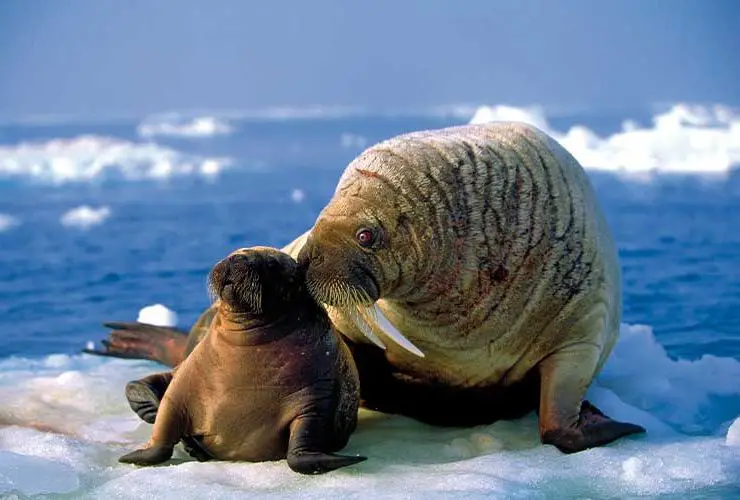
Walruses are primarily threatened by climate change, as the loss of sea ice affects their ability to rest and breed. They also face threats from hunting and oil and gas development.
The IUCN lists the Walrus as “Vulnerable,” indicating that it is at high risk of endangerment in the wild. There are also specific conservation efforts directed towards Walruses, including habitat protection and management of hunting.
| Aspect | Sea Lion | Walrus |
| Common Threats | Overfishing of prey, entanglement in fishing gear, habitat degradation, climate change | Climate change (loss of sea ice), hunting, oil, and gas development |
| IUCN Status | Varies greatly between species (e.g., Near Threatened to Extinct) | Vulnerable |
| Conservation Efforts | Vary by species and region | Habitat protection, management of hunting |
11. Sea Lion vs Walrus: Who Would Win the Battle
The walrus would probably win in a fight between a sea lion and a walrus.
Walruses are way bigger and heavier than sea lions. They have strong tusks that stab deep into the opponent. Their thick layer of blubber can also protect them from a sea lion’s attacks.
Sure, sea lions are agile and excellent swimmers, but they’re not built to handle the size and strength of a walrus in a direct showdown.
Because of the walrus’s larger size, thick blubber, and those powerful tusks, it’s more likely to win in a fight against a sea lion.
Wrapping Up
So, are sea lions and walruses the same? Sea lions and walruses, though often confused, are two spectacular marine mammals that share a few similarities but also boast a wealth of differences. They have each evolved distinct features and behaviors to suit their specific environments and ways of life.
Sea lions often inhabit the temperate waters of the Pacific, while walruses live in the Arctic’s icy realms. Despite their disparities, both sea lions and walruses are equally fascinating, each with its own story to tell.
We hope our blog post has quenched your thirst for knowledge and given you a greater appreciation for the rich life in our oceans. Dive in again anytime!

